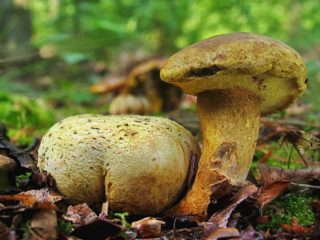Content
Larch boletus is a tubular mushroom that has several names: Larch boletin, Phylloporus lariceti, Boletinus lariceti. The species is classified in the third group in terms of nutritional value. Fruit bodies with a weak odor and unexpressed taste are suitable for any processing method.
What larch moss mushrooms look like
Larch moss fly forms the monotypic genus Psiloboletinus (Psiloboletin) and is its only representative.
The moss fly received its specific name from its growth method. It is found only near larch in pine forests or mixed forests, which include coniferous trees. It was listed in the biological reference book in 1938 by mycologist Rolf Singer. External description of the type:
- The upper part of the fruiting body is rounded, with very concave edges; as it matures, the cap becomes prostrate, reaching an average diameter of 15 cm, but there are also larger specimens.
- The surface is velvety, dry, the edges of the cap in adult representatives are smooth or wavy, slightly concave.
- The color is dark gray or brown, often uniform, with possibly a small ocher spot in the center.
- The hymenophore is tubular, finely lamellar along the edge. The pores are large, with thick walls, descending onto the stalk, visually perceived as thick plates.
- The color of the spore-bearing layer in young fruiting bodies is white or light beige, turning yellow with age.
- The pulp is light, thick, dense, with a slight mushroom smell and weak taste. When scrapped it turns blue.
- The leg is of medium thickness, its length is 6-10 cm, the surface is velvety, light on top, and dark near the mycelium. It can be flat or slightly thickened at the base or in the middle part.
- The larch moss fly is missing a ring on the stem and a cover.
Where do larch moss mushrooms grow?
Moss fly can be found only under larch; it often grows singly, less often in 2-3 copies. Distribution area: Ural, Far East, Eastern Siberia. The species is not particularly popular here. It grows abundantly on Sakhalin, is collected en masse, and the product is widely used for winter harvesting. Fruiting time is the end of August. The duration of collection depends on the amount of precipitation, lasts within 2-3 weeks, grows only in Russia.
Is it possible to eat larch mushrooms?
Universal to use, does not require special processing.The product is washed to remove dirt, dry fragments of leaves and grass, and is suitable for frying without prior boiling. Larch moss is used for salads, soups, and mushroom caviar. Prepared for the winter in pickled or dried form.
False doubles
Species similar to the larch moss fly include the thin moss.
Young mushrooms are very similar to each other. Adult specimens can be distinguished by the spore-bearing layer: in the pig's case it is lamellar, but with wavy edges. Outwardly similar to tubular, the difference is noticeable only upon careful examination. When oxidized, the juice from the double turns brown rather than blue. The species contains lectins in its chemical composition - toxic compounds that are preserved during heat treatment.
The poisonous twin grows in all types of forests, often settles on trunks, is rarely found individually, and mainly forms colonies.
Another doppelgänger, the bluish gyrodon or under-tree, grows in symbiosis with alder. This is the main distinguishing feature of the species.
The tubular mushroom is characterized by high nutritional value. The damaged areas turn bluish, then darken to brown. Girodon is a rare mushroom, protected by law in some European countries.
Another representative of the mushroom kingdom can be called a double: Kozlyak belongs to the genus Maslenok, characterized by a low nutritional rating.
It is considered conditionally edible and included in the last (IV) category. The color of the fruiting body is lighter than the larch moss. The pulp is yellow in color, when scrapped it becomes pink, then red. Forms mycorrhiza with pine.
Collection rules
The main condition is not to pick mushrooms in an environmentally polluted area. Growth areas near industrial enterprises, highways, gas stations, and landfills are not considered.
Only young specimens are taken; from overripe larch moss mushrooms, the hymenophores become jelly-like and separate from the cap, the decomposing protein gives the mushroom an unpleasant odor, such fruiting bodies are not collected due to their poor presentation, as well as the appearance of toxins in their composition, which can cause severe poisoning.
Use
Larch flywheel does not have a strong taste or smell, but is quite suitable for all types of processing. The fruiting bodies can be immediately used for cooking. Through laboratory studies it has been proven that larch flywheel secretes an enzyme that has a thrombolytic effect. In folk medicine, dried mushrooms or decoctions are used to thin the blood and prevent the formation of blood clots.
Conclusion
Larch moss is the only representative of the genus Psiloboletin, which is distributed only in Russia (mainly Western Siberia and the Urals). A mushroom with low nutritional value, edible, used in all types of processing. It grows only under larch.













